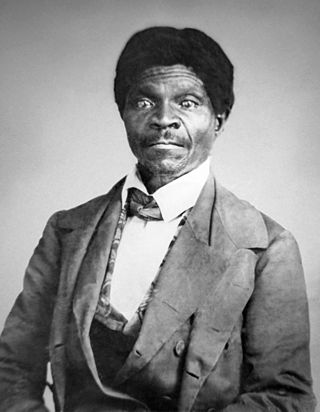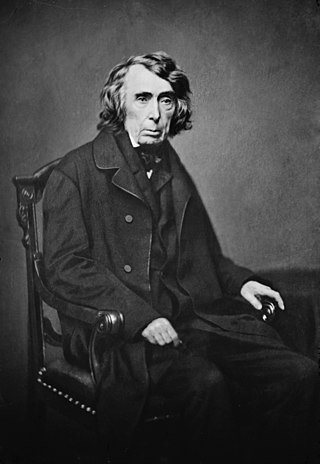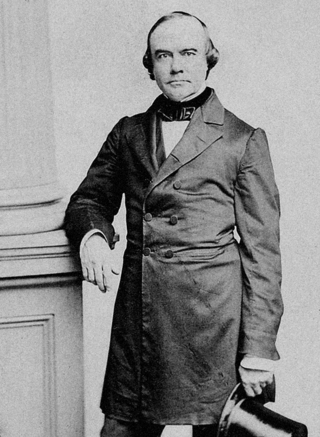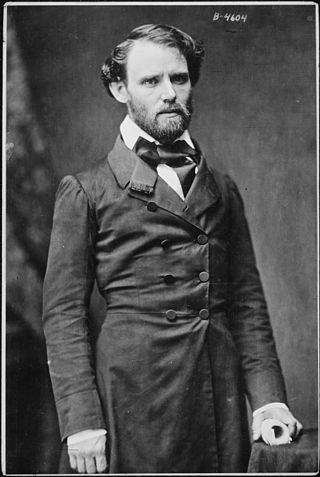
The Pulitzer Prize for History, administered by Columbia University, is one of the seven American Pulitzer Prizes that are annually awarded for Letters, Drama, and Music. It has been presented since 1917 for a distinguished book about the history of the United States. Thus it is one of the original Pulitzers, for the program was inaugurated in 1917 with seven prizes, four of which were awarded that year. The Pulitzer Prize program has also recognized some historical work with its Biography prize, from 1917, and its General Non-Fiction prize, from 1962.
Dred Scott v. Sandford, 60 U.S. 393 (1857), was a landmark decision of the United States Supreme Court that held the U.S. Constitution did not extend American citizenship to people of black African descent, and thus they could not enjoy the rights and privileges the Constitution conferred upon American citizens. The decision is widely considered the worst ever rendered in the Supreme Court's history, being widely denounced for its overt racism, perceived judicial activism and poor legal reasoning, and for its crucial role in the start of the American Civil War four years later. Legal scholar Bernard Schwartz said that it "stands first in any list of the worst Supreme Court decisions". Chief Justice Charles Evans Hughes called it the Court's "greatest self-inflicted wound".

Dred Scott was an enslaved African American man who, along with his wife, Harriet, unsuccessfully sued for freedom for themselves and their two daughters in the Dred Scott v. Sandford case of 1857, popularly known as the "Dred Scott decision". The case centered on Dred and Harriet Scott and their children, Eliza and Lizzie. The Scotts claimed that they should be granted their freedom because Dred had lived in Illinois and the Wisconsin Territory for four years, where slavery was illegal, and laws in those jurisdictions said that slaveholders gave up their rights to slaves if they stayed for an extended period.

Ex parte Merryman, 17 F. Cas. 144 (No. 9487), was a controversial U.S. federal court case that arose out of the American Civil War. It was a test of the authority of the President to suspend "the privilege of the writ of habeas corpus" under the Constitution's Suspension Clause, when Congress was in recess and therefore unavailable to do so itself. More generally, the case raised questions about the ability of the executive branch to decline enforcement of judicial decisions when the executive believes them to be erroneous and harmful to its own legal powers.
A number of cases were tried before the Supreme Court of the United States during the period of the American Civil War. These cases focused on wartime civil liberties, and the ability of the various branches of the government to alter them. The following cases were among the most significant.

Benjamin Robbins Curtis was an American lawyer and judge. He served as an associate justice of the United States Supreme Court from 1851 to 1857. Curtis was the first and only Whig justice of the Supreme Court, and was also the first Supreme Court justice to have a formal law degree. He is often remembered as one of the two dissenters in Dred Scott v. Sandford (1857).

George Ellis Pugh was a Democratic politician from Ohio. He served in the U.S. Senate from 1855 to 1861.
Prigg v. Pennsylvania, 41 U.S. 539 (1842), was a United States Supreme Court case in which the court held that the Fugitive Slave Act of 1793 precluded a Pennsylvania state law that prohibited blacks from being taken out of the free state of Pennsylvania into slavery. The Court overturned the conviction of slavecatcher Edward Prigg as a result.

The House Divided Speech was an address given by senatorial candidate and future president of the United States Abraham Lincoln, on June 16, 1858, at what was then the Illinois State Capitol in Springfield, after he had accepted the Illinois Republican Party's nomination as that state's US senator. The nomination of Lincoln was the final item of business at the convention, which then broke for dinner, meeting again at 8 PM. "The evening session was mainly devoted to speeches", but the only speaker was Lincoln, whose address closed the convention, save for resolutions of thanks to the city of Springfield and others. His address was immediately published in full by newspapers, as a pamphlet, and in the published proceedings of the convention. It was the launching point of his unsuccessful campaign for the senatorial seat held by Stephen A. Douglas; the campaign would climax with the Lincoln–Douglas debates. When Lincoln collected and published his debates with Douglas as part of his 1860 presidential campaign, he prefixed them with relevant prior speeches. The "House Divided" speech opens the volume.
Paul Finkelman is an American legal historian, the Robert E. and Susan T. Rydell Visiting Professor at Gustavus Adolphus College in St. Peter, Minnesota, and a research affiliate at the Max and Tessie Zelikovitz Centre for Jewish Studies, Carleton University, Ottawa, Canada. He is the author or editor of more than 50 books on American legal and constitutional history, slavery, general American history and baseball. In addition, he has authored more than 200 scholarly articles on these and many other subjects. From 2017 - 2022, Finkelman served as the President and Chancellor of Gratz College, Melrose Park, Pennsylvania.

Don Edward Fehrenbacher was an American historian. He wrote on politics, slavery, and Abraham Lincoln. He won the 1979 Pulitzer Prize for History for The Dred Scott Case: Its Significance in American Law and Politics, his book about the Dred Scott Decision. In 1977 David M. Potter's The Impending Crisis, 1848-1861, which he edited and completed, won the Pulitzer Prize. In 1997 he won the Lincoln Prize.

The Taney Court refers to the Supreme Court of the United States from 1836 to 1864, when Roger Taney served as the fifth Chief Justice of the United States. Taney succeeded John Marshall as Chief Justice after Marshall's death in 1835. Taney served as Chief Justice until his death in 1864, at which point Salmon P. Chase took office. Taney had been an important member of Andrew Jackson's administration, an advocate of Jacksonian democracy, and had played a major role in the Bank War, during which Taney wrote a memo questioning the Supreme Court's power of judicial review. However, the Taney Court did not strongly break from the decisions and precedents of the Marshall Court, as it continued to uphold a strong federal government with an independent judiciary. Most of the Taney Court's holdings are overshadowed by the decision in Dred Scott v. Sandford, in which the court ruled that African-Americans could not be citizens. However, the Taney Court's decisions regarding economic issues and separation of powers set important precedents, and the Taney Court has been lauded for its ability to adapt regulatory law to a country undergoing remarkable technological and economic progress.

The inauguration of James Buchanan as the 15th president of the United States was held on Wednesday, March 4, 1857, at the East Portico of the United States Capitol in Washington, D.C. This was the 18th inauguration and marked the commencement of the only four-year term of both James Buchanan as president and John C. Breckinridge as vice president. Chief Justice Roger B. Taney administered the presidential oath of office. This was the first inauguration ceremony known to be photographed.

John Catron was an American jurist who served as an Associate Justice of the Supreme Court of the United States from 1837 to 1865, during the Taney Court.

Robert Cooper Grier was an American jurist who served on the Supreme Court of the United States.

John McLean was an American jurist and politician who served in the United States Congress, as U.S. Postmaster General, and as a justice of the Ohio and U.S. Supreme Courts. He was often discussed for the Whig Party nominations for President, and is also one of the few people who served in all three branches of government.

Lemmon v. New York, or Lemmon v. The People (1860), popularly known as the Lemmon Slave Case, was a freedom suit initiated in 1852 by a petition for a writ of habeas corpus. The petition was granted by the Superior Court in New York City, a decision upheld by the New York Court of Appeals, New York's highest court, in 1860 on the eve of the Civil War.

Hugh Alfred Garland was an American lawyer and politician. He served in the Virginia House of Delegates. In 1838 to 1841 he served as clerk of the United States House of Representatives. Garland, a slave owner, was a staunch supporter of slavery in the United States, and he led the defense for Dred Scott's owner, John F. A. Sanford, in the case of Dred Scott v. Sandford, but died three years before the case was argued before the United States Supreme Court.













